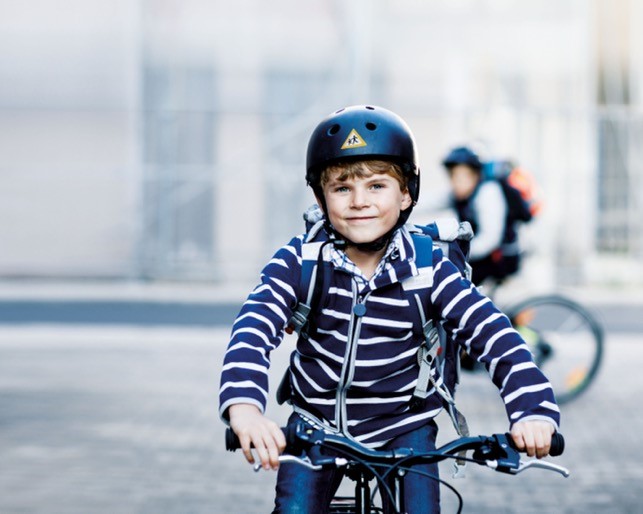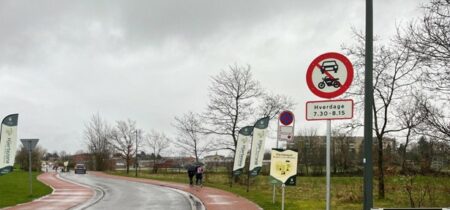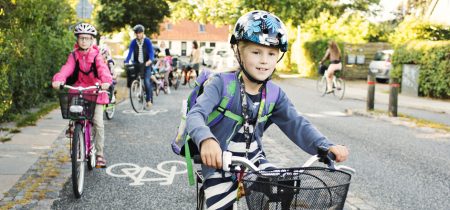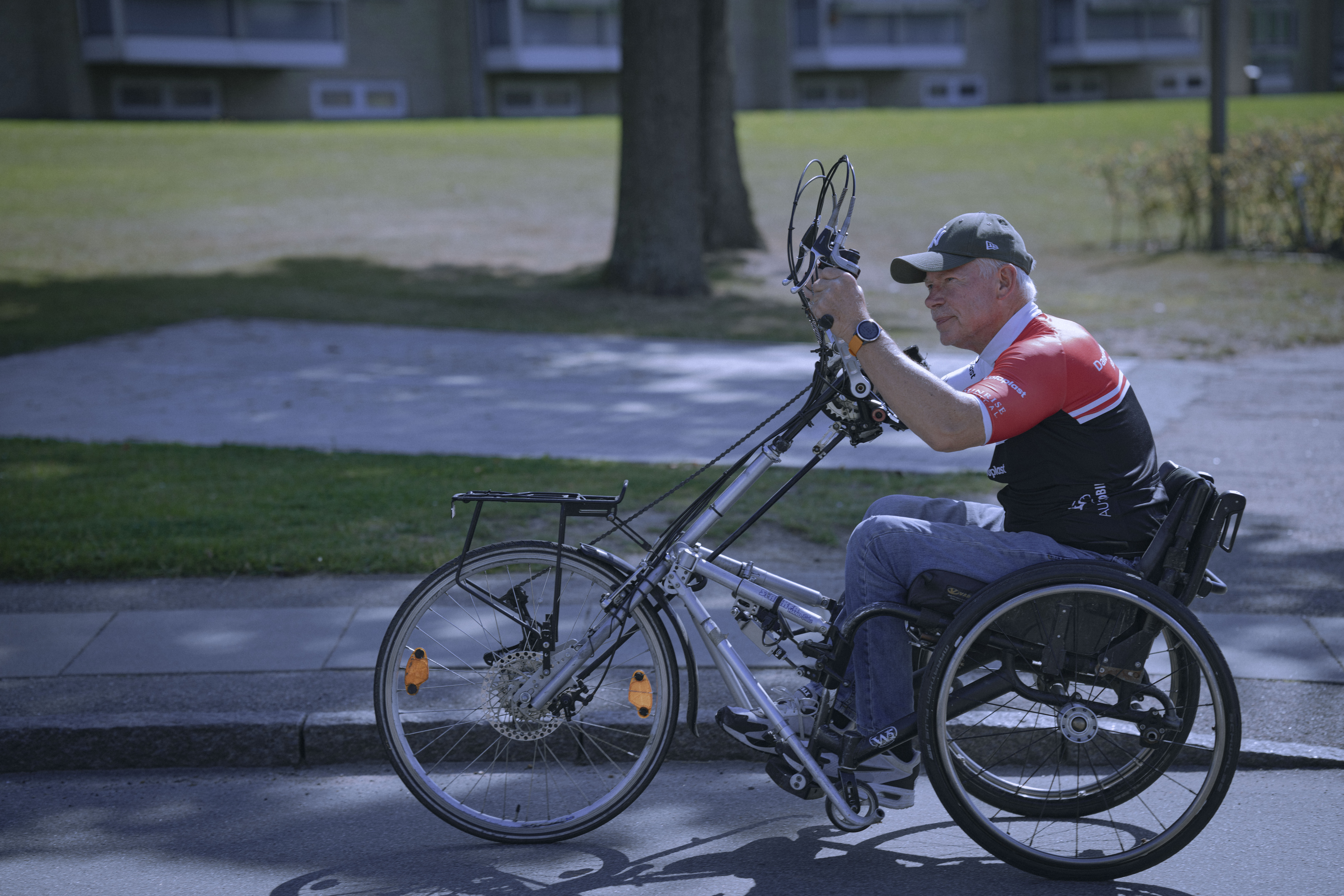Students as traffic experts
Students as traffic experts
– How can students get more people to cycle and walk to school?

With support from Cykelpuljen 2021 and the foundation Østifterne, the company Trafik i Børnehøjde has carried out the innovation project ‘Students as traffic experts – behavior before construction’. The project aims to create a greater knowledge base and documentation of the effect of student involvement in behavior-based traffic solutions at schools. In addition, the project has developed inspirational material for schools to inspire teachers to involve their students in the development of various initiatives that encourage more children to cycle or walk to school.
This article presents the inspirational material and the results of the project.
Johan Heichelmann, johan@bornetrafik.dk, Trafik i Børnehøjde
The project was carried out by Trafik i Børnehøjde with support from Østifterne and Cykelpuljen 2021 in collaboration with COWI, Cyklistforbundet and Rådet for Sikker Trafik. The project was carried out at four schools with one project in each of the following municipalities; Aalborg, Assens, Albertslund and Copenhagen.
- One purpose of the project is to document the great potential of involving students in solving the schools’ traffic challenges, and to convince more traffic managers in the municipalities that it is worthwhile to think about school road projects in a more interdisciplinary and user-oriented way.
- The second purpose of the project is to inspire more schools to start student involvement on their own. In an inspirational material, we give our suggestions for activities that schools can carry out on their own.
Why involve students in traffic projects?
Trafik i Børnehøjde has over 10 years of experience involving students in traffic projects around schools, and we see several good reasons to involve students. Our understanding of student involvement is that students have a lot to contribute to the mapping of traffic, as well as the development and execution of solutions. However, it is important to emphasize that we use our traffic expertise to select the initiatives that we know will have the greatest effect, and that this is done in dialogue with the municipality’s traffic manager and school staff.
Students know their route to school best
An obvious reason to involve students is that they have a wealth of knowledge about their route to school, which is used in the mapping phase at the start of projects. Students use the roads all year round. Children possess knowledge that professionals in the municipalities and we at Traffic in Children’s Heights do not always have. The pupils have an in-depth knowledge of the school run. In addition, students can talk about their experiences on the roads from a child’s perspective, as traffic on the roads can be experienced very differently whether you are a child or an adult. Where is it nice to be on the road, where is it less nice and why?
Students as ambassadors
Students are very creative in their solutions, especially when it comes to coming up with solutions that appeal to the rest of the school. When the projects are presented to the rest of the school, the students are also involved in presenting and showing the solutions to the rest of the school. We know from experience that younger students listen with interest to older students, making it easier for them to understand what they need to do in traffic in the future. Similarly, we have found that parents are more receptive to the messages when they come from the school’s children than from the school’s staff. For example, several school leaders have told us that they have tried for many years to communicate to the school’s parents about traffic behavior around the school without success. We see students as ambassadors and role models.
Student involvement engages schools
Student engagement is a means of engaging schools to take more responsibility for traffic and focus on behavior. When their students are engaged and come up with exciting solutions that solve problems, schools are more likely to take responsibility for embedding the initiatives and maintaining good traffic habits at school. Our results show that student involvement engages schools to take more responsibility for traffic.
Impact measurements
Using drone footage, COWI documented the effect of the measures with before and after measurements at the two schools in Aalborg and Copenhagen. For the two schools, COWI has prepared a report that explains the effect of the measures and makes recommendations on how the municipality and school can maintain the good behavior. Read COWI’s reports on the website: http://bornetrafik.dk/adfaerd-for-anlaeg/.
New traffic measures
Below is a brief presentation of the solutions and results at the two schools where COWI conducted drone footage.
Christianshavns Skole, Copenhagen.
New school road – developing a new, exciting universe around the school
At Christianshavns Skole, the problem was that the school’s main entrance from Prinsessegade is used by many students and parents by bike and on foot. This meant that dropping off students and parking cargo bikes on the sidewalk and bicycle path to a degree that created a sense of insecurity for the students.
The students developed two solutions:
- drop-off zone in the schoolyard. This is to reduce the number of road users on the sidewalks and bike path. The zone works by parents cycling in through one gate and out through another.
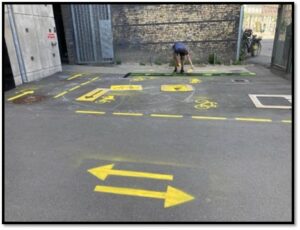
The drop-off zone at the school’s main entrance
2. New school route. The students have developed a new and exciting universe around the school’s second entrance. The path was named the ‘Fairy Tale Path’ and the students decorated the path in collaboration with a performing artist. The Adventure Path is intended to appeal to younger students in particular as a new route to school. The aim is to relieve the congested main entrance.
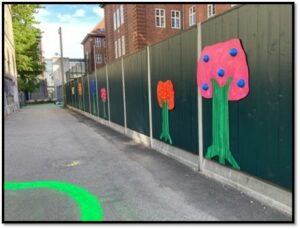
COWI’s drone footage showed that 15% more people used the Adventure Path in the morning, which resulted in less congestion in front of the school’s main entrance. The drop-off zone in the schoolyard is clearly seen being used in the last drone footage, which contributes to less traffic in front of the school, i.e. more safety for the students. In addition, the footage showed an increase of 36% more cyclists than before the start of the project.
Vester Mariendal School, Aalborg.
Separation of road users around the school
At Vester Mariendal School, the problem was that cyclists and pedestrians came into conflict with drivers in the school’s parking lot. At another location, students experienced insecurity on a shared path, as many cyclists and pedestrians made students feel squeezed.
The students developed two solutions:
- Safe pathway across the parking lot and kiss-and-drive area.
The students developed an idea where parents in cars have to drop their children off at a certain place in the parking lot so that they don’t make the school road unsafe for the students. A safe passage for pedestrians was marked across the parking lot to make drivers aware that there are students crossing the lane.
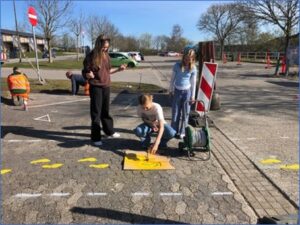
Students help design the safe path across the parking lot.
2. Shared path. The students have suggested dividing the shared path to make it clearer and easier for pedestrians and cyclists to position themselves correctly.
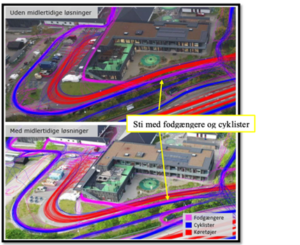
The image shows that the path subsequently appears more divided between pedestrians and cyclists.
COWI’s drone footage shows that drivers are less likely to cross the light road users’ lane and more likely to use the newly established ‘kiss-and-run’. The proportion of light road users crossing the parking lot on the safe path has also increased. However, the area around the school is characterized by a lot of commuter traffic and it is therefore not possible to accurately distinguish commuters from people on their way to school.
On the former shared path, the drone footage shows that pedestrians and cyclists are more separated in the situation where road users are divided.
Learning opportunities in student engagement
We have received very positive feedback from teachers in relation to involving students in the development of traffic and cycling projects at schools. In particular, teachers emphasize the learning and educational perspectives of involving students in both the development and execution of a project. However, it can be difficult for individual schools to carry out a large-scale student involvement process on their own, without guidance from municipal engineers or Traffic at Children’s Level.
Inspirational material
That’s why we’ve developed inspirational material for teachers, where we provide three examples of how students can help develop traffic projects at a school.
We have emphasized that the teacher and students can carry out the examples on their own with the support of the school’s management.
In the material, we provide inspiration for developing and initiating the following:
- Bicycle recess. Teachers get inspiration on how they, together with the students, can initiate bike breaks at school so that students can cycle more during school hours.
- Cycling activities and a competition. Teachers get inspiration on how they, together with their students, can initiate theme days about cycling and how to create a competition that encourages more children to cycle and walk to school.
- New school route. Teachers get inspiration on how they, together with their pupils, can make an alternative school route more attractive for the school’s pupils, possibly with the help of decorations.
Source references/links
The inspirational material can be found here: http://bornetrafik.dk/inspirationsmateriale-elever-som-trafikeksperter/
The reports from COWI can be found here: http://bornetrafik.dk/adfaerd-for-anlaeg/
———————————————————————————————————————————————–
Category for the article: Children on bikes


